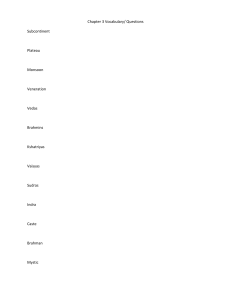File
advertisement
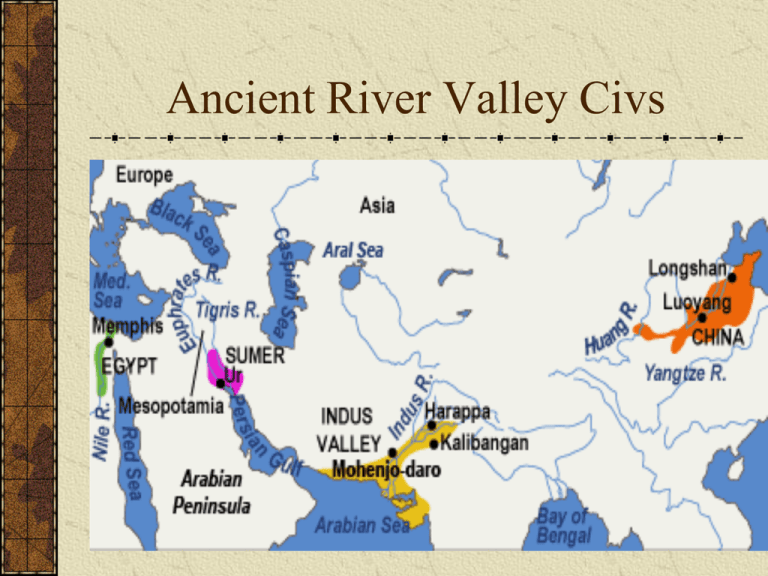
Ancient River Valley Civs What do the River Valley Civs have in common? GEOGRAPHY: settled near rivers; located along a similar line of latitude and therefore had a similar climate POL: rulers had divine power; gained right to rule from a sun god; cities ECO: agrarian based; access to water allowed for food surpluses; job specialization; traditional economy REL: Polytheistic; religion created to promote divine intervention to control the forces of nature and afterlife; sun god and river god were main gods SOC: since there was job specialization there was a social class system that had a true hierarchy with rulers and priest ranking high INT: writing systems; pottery and metallurgy; domestication of animals; irrigation systems ARTS: pottery, art as a reflection of culture; art typically seen in religion ANCIENT MESOPOTAMIA Oldest known civilization Cradle of Human Civilization Old Testament Ziggurat (right) Hanging gardens Geography of Mesopotamia Located in the Middle East where modern day Iraq is This civ rose in the valleys between the Tigris and Euphrates rivers; relatively flat Some say this Fertile Crescent was the real Garden In Greek, Mesopotamia of Eden. means the land between 2 rivers. Modern day location-IRAQ Political Organized into city-states; WHY?? decentralized Sumer and Ur were a couple of early cities Babylon became popular because of Hammurabi’s Code…Why significant? Hammurabi’s Code 1st written law code Why is a written law code important? Crime and punishment were laid out in writing Did treat people of different socioeconomic status differently Political:What was the earliest kingdom in Mesopotamia? The second? Early Mesopotamia used city-state organization; Babylon would start out as a city-state and then conquest surrounding territories and become an empire. The Assyrian would take them over and then the Persians would take them over. Economic Map Showing interaction of the Early River Valley Civilizations Agrarian based as well as widespread use of domesticated animals; what were some examples? trade with the Egyptians and the Indus Valley civilizations. How would historians be able to determine that? What could trade between rival city-states help ensure? Religion Farmlands were considered sacred Priests organized work teams Gods seen as human forms that depicted forces of nature The first monotheistic religion was developed in Mesopotamia Hebrews; a Semitic people believed that there God was an all powerful; origins of Judaism Ziggurats Purpose? Social Ruling family, officials and high priests Warriors and other Religious officials Merchants and artisans Peasant farmers and slaves Food surpluses supported leaders, priests and artisans Intellectual Writing system was Cuneiform…why significant? Beer making currency, and bride price Algebra and geometry First wheeled vehicles The Hittites made iron…how would that help society? Coined money Sumerians invented the wheel! The wheel was invented by 6000 BCE! It helped military, farming and trade. At right, this is made of wood. cuneiform writing ARTS What did you get? That concludes Mesopotamia. Any questions before the quiz on the next slide? Mesopotamia Quiz Political:What law code was created in the Mesopotamia? Why significant? Why did they need to develop into city-states? Economic: How did Mesopotamians earn a living? Geography:Between what 2 rivers did the Fertile Crescent appear? Social:What type of writing did they use? ANCIENT EGYPT Nile River Mummies Pharaoh King Tutankhamen Hieroglyphics Political Egyptians were led by Pharaohs. They were kings who held absolute power who were descents from a god Political decisions were influenced by religions Centralized Gov’t…WHY????? King Tut is the most famous He came from a dynasty Tutankhamen Economy Raised veggies, grains and animals Egyptians traded up and down the Nile, with Mesopotamians and sometimes with Indus Valley (in modern day Pakistan) Religion Pyramid building for the afterlife for wealthy Beer and just about everything else was put in the tombs Most sophisticated of all the polytheistic systems during the period Social Grain surpluses given to Pharaohs and priests Pharaoh Priests Nobles and warriors Artisans and merchants Anyone else? Slaves Intellectual Hieroglyphics Pyramids Mummies Advanced medical knowledge Irrigation, but why not as worrisome as other civs? Pyramids These are the Giza pyramids, the most famous. Pyramids were tombs for the kings. These were built around 3500 B.C.E. How old are they? What can we gather from these structures? Mummies Egyptians who could afford to do so would have themselves mummified. They believed in a better afterlife if their body was preserved. Even their pets went with them to the afterlife Egyptians wrote in hieroglyphics Diffused from cuneiform That concludes Egypt. Any questions before the quiz on the next slide? Egypt Quiz 1.GeographyWhat river is the basis for Egyptian civilization? 2. Political What is an Egyptian ruler called? 3. Intellectual What writing system did Egyptians use? 4. Intellectual What impact to mummification have on their learning? Geography: What modern day countries is the Indus Valley civ in? Indus was located on the subcontinent of India located in what is now modern day Northern Indian and Pakistan What are monsoons? How did it affect the Indus? Indus River Valley This civ is still mysterious due to the fact that the writing has yet to be deciphered. The archeological evidence have helped out historians drawn conclusions though Nearly destroyed by Aryan invasions at the end of the River Valley Period Political/Cities We do know the cities were sophisticated enough to have brick walls surrounding them for protection against flooding from the Indus River. Harappa and Mohenjo-Daro, although located on different parts of the Indus were nearly identical in lay-out VEY SIMILAR INFRASTRUCURE What conclusions, politically, can be drawn then? Various artifacts found Indus Economy Just like the other river valley civs, the Indus river valley people were mostly farmers. Traditional economy granaries They did trade with Mesopotamians and Egyptians and perhaps Northern China EXAMPLE: Hittite Iron for Indus cotton Religion Large figurines were discovered and it was determined that they represented gods/goddesses Later Aryans, conquested in 1500BCE; set up a caste system and began what would become Hinduism Social Since there was job specialization there was a social hierarchy Most people were farmers Later, Aryans would bring their own social class putting them on top of society Intellectual Tremendous infrastructure: public buildings, baths, granaries, sanitation systems Houses were made out of bricks which had plumbing and links to the sewer First civ to grow cotton and weave it into cloth Had time to make games; origins of dice and chess can be traced back to Indus That concludes Indus River Valley Civilization. Get ready for the quiz on the next slide. Indus River Quiz P: Why do we know so little of the power structure in the Indus Valley? E: How did the Indus make a living? G:In what modern day country are the settlements of the Indus River Valley civilization? G:Why did the cities have so many walls? S: How did the Aryans impact people of the Indus? ANCIENT CHINA Began 2000 B.CE. Silk Astronomy River of Sorrows Oracle Bones Yellow River Civilization Geography: Ancient China was formed around the Yellow River...Chinese name? Huang He Why called yellow? River of Sorrows? Political Oracle bones helped to keep records and therefore provided evidence of the family that ruled China at this time The first dynasty was the Shang and they ruled during the River Valley Period. The Shang family needed help to control the people along the Yellow River. It meandered a lot and was hard for one family to control Would this be centralized control or decentralized? Specifically which type of decentralization? Feudal Other dynasties will emerge but later Economic Agrarian-based traditional economy with sophisticated irrigation systems that included dams and canals Job specialization Religion The oracle bones are the earliest known significant examples Chinese writing, and contain important complete royal genealogy of the Shang dynasty. These records confirmed the existence of the Shang dynasty Served religious purposes as well Polytheistic Social Resembled that of other cultures Shang family: Reigned but did not rule Nobles and warriors: landowners Merchants and artisans Peasants and slaves Intellectual During the Shang period, the Chinese made remarkable achievements in astronomy bronzework learned to make silk developed a complex system of writing Chinese invented silk Silk was exotic and expensive, so it was good for trading with the rest of the known world. It is made from silk worms. Silk worm That concludes China. Any questions before the quiz on the next slide? Ancient China Quiz P: What was the dynasty? E: How did the Chinese earn a living? G: What river was the earliest Chinese civilization centered around? Other names? S: What technological advancements did the Chinese have? Nubia 3100 BCE-350 CE Located south of Egyptian civilization Early culture – 2300-1100BCE Nubia’s location and natural wealth, like gold on a trade route between Egypt and subSaharan Africa allowed to rise to become a complex civilization At time, the two – Egypt and Nubia fought for control of resources and as a result, Nubian culture and technology were influenced by Egypt Evidence indicates that Nubia was even influenced by lands to their south as evidenced by the role of queens Meroe was a city that was large and impressive with monumental buildings and streets; it was the center of agriculture, trade and metallurgy Nubia fell c. 300CE due to trade shifting and attacks by desert nomads Celtic Europe 1000-50 BCE Migrations around 500 BCE An Indo-European people who settled in modern day Germany, Austria, Czech Republic, France, Britain, Ireland Merged with indigenous peoples to create a unique culture in northern Spain Due to their wide range of territory, there is no “Celtic Civilization” in terms defined territory Society Elite warriors, priest, and commoners Warriors owned flocks of cattle and sheep giving them wealth and power Houses built out of wood, clay and straw Druids were priests and they helped to link the tribes and settle disputes Women ere better off than other civs Religion was elaborate with more than 400 gods and used nature rather then temples to pray Early American Civilizations Migrations out of Asia when there was still a “Land” bridge 16,500 years ago Olmecs 1300-400 BCE Located in Southern Central Mexico They are often regarded as the Mother Culture of later Mesoamerican civilizations. Some researchers say they descended from Asians Olmec Characteristics Built the first planned city in Central America. Used slash and burn to create food surpluses IRRIGATION - STONE DRAIN SYSTEMS- aqueducts pyramid–shaped temples WRITING- hieroglyphics (ORIGINAL) developed a number system with a zero accurate calendar the gigantic stone heads. Chavin 900 BCE to 200BCE Located far south of the Olmecs Did not interact with Olmecs 1st civilization in South America existing 2,000 years before Incas Known as an Andean Civilization because they are located in the Andes Mts. Located near rivers but in highlands…how would they created food surpluses then? Chavin characteristics Built temples Cultivated maize, potatoes and quinoa (super grain) Domesticated llamas; used to transport goods and hair for weaving Gold metallurgy

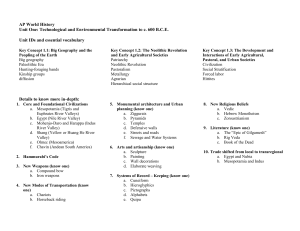

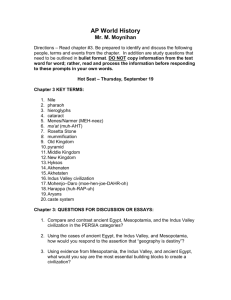
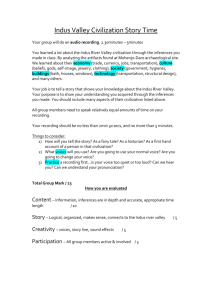
![Indus[1] - ridgeaphistory](http://s3.studylib.net/store/data/006736077_1-c59280ecd30594bac8ab21ec7bce4db4-300x300.png)
